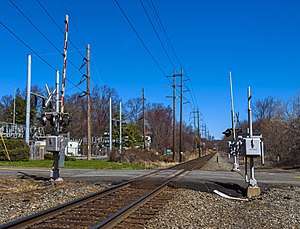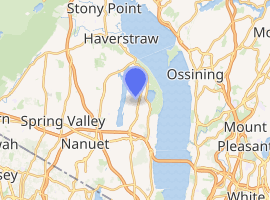Gilchrest Road, New York crossing accident
The Gilchrest Road crossing accident was a grade crossing accident that occurred on March 24, 1972 in the town of Clarkstown, New York, between the hamlets of Valley Cottage and Congers, roughly 25 miles (40 km) northwest of New York City. Five students from Valley Cottage were killed, and 44 others were injured.
| Gilchrest Road crossing accident | |
|---|---|
 The grade crossing in April 2018, seen from the southeast | |

| |
| Details | |
| Date | March 24, 1972 |
| Location | Clarkstown, New York |
| Coordinates | 41.1338°N 73.9452°W |
| Country | United States |
| Line | School bus |
| Incident type | Grade crossing |
| Cause | Bus driver's failure to yield at a grade crossing |
| Statistics | |
| Vehicles | Freight train and school bus |
| Deaths | 5 |
| Injuries | 46 |
The Penn Central (formerly New York Central) railway crossing at Gilchrest Road West, just outside Valley Cottage, contained only crossbucks and lacked additional warning hardware, such as flashing lights, crossing gates or a warning bell. The railway line was also difficult for road vehicles to see due to the curvature of the road and lineside trees.
Accident
On the morning of March 24, 1972, 35-year-old Joseph Larkin was driving a Nyack High School school bus, loaded past capacity, downhill on Gilchrist Road. The bus was filled with 48 passengers, 31 males and 17 females with some passengers standing due to lack of room.[1] Penn Central freight train number 2653 (for its lead locomotive, a GE U25B), traveling at 25 miles per hour (40 km/h) with 83 loaded freight cars (73 from origin at Weehawken, New Jersey, plus ten more picked up en route at North Bergen), destined for Penn Central's Selkirk, New York yard, was heading towards the Gilchrist Road crossing, and began blowing its horn. Larkin did not decrease the speed of the bus as he approached the grade crossing. The train engineer saw the bus cross the tracks and immediately applied the brakes. However, the train's momentum carried it through the crossing, where it collided with the bus. The freight train ripped through the school bus, severing it into two sections, with the front half coming to rest a quarter mile (1,116 ft) down the tracks. The rear section of the bus was torn loose, and fell off next to the tracks upside down with a number of students still inside, while several other students were ejected from the remaining portion of the bus, passing through separated floor sections and fell between the rails into the path of the train.[2]
Three students, Jimmy McGuiness (17), Richard Macaylo (18), and Bobby Mauterer (14), were killed instantly.[3] Forty-five more students and Larkin were rushed to a nearby hospital, where 14-year-old Thomas Grosse died from his injuries several days later. 16-year-old Stephan Ward died on April 14.[4] Some of the children that survived required artificial limbs.[5] One reporter wrote that in the aftermath that the hospital had "...anguished mothers, some still clad in bathrobes, crowded the hospital lobby seeking information on their children."[3] None of the train crew were injured in the accident.[5]
Survivor Timothy Wilkins described that, "All of a sudden, someone yelled, 'Train.' I looked up and the train was there. I heard the train brakes and I heard the engine..."[6]
Trial
Larkin was brought to trial and charged with criminally negligent homicide in the death of the five students.[6] Larkin claimed he had come to a complete stop and looked both ways before the collision; sixteen witnesses claimed he did not. Larkin was given probation; the judge told him "You will be punished for the rest of your life and you deserve to be."
At the time of the accident, Larkin was a fireman and a part-time bus driver who had been driving the route less than a week. The surviving children admitted to the fact they did not like Larkin, claiming he frequently drove aggressively and tried to beat other cars to an intersection. Larkin was sentenced to five years of probation and died on October 20, 1998. He is buried in the Gate of Heaven Cemetery in Hawthorne.[7]
The current railway crossing at Gilchrest Road West is now protected with crossbucks, flashing lights, and safety gates. Frequent freight trains are operated there by CSX Transportation. This accident helped change the law requiring school buses to stop, open their bus door, and listen for a specific amount of time before crossing any railroad track.
Aftermath
After the accident there was public outcry and anger against the driver and the fact that there were no warning gates or lights at the crossing.[3] On September 22, 1972 the National Transportation Safety Board directed a recommendation relating to the accident towards the National Highway Traffic Safety Administration.[5] Louis M. Thayer was part of the five member board of the Federal Agency to question witnesses and investigate the accident.[8]
A mass for three students who were killed were held at St. Paul's Roman Catholic Church in Congers. A special interdenominational prayer service for the recovery of the injured was held as part of the Palm Sunday observance at All Saints Protestant Episcopal Church in Valley Cottage.[8]
Because of the accident, the New York State Department of Motor Vehicles established article 19-A, which is a system that all bus drivers must be qualified to drive by completing a certain amount of requirements, which include, biennial medicals (with follow-ups if needed), biennial written or oral tests, biennial road tests, yearly defensive driving tests, yearly license abstracts, and fingerprints with criminal history reviews. Article 19-A was established in 1974, two years after this tragic accident.
See also
- 1972 in rail transport
- 1972 in the United States
- List of American railroad accidents
- List of level crossing accidents
- List of rail accidents (1970–79)
- 1995 Fox River Grove bus–train collision, similar grade-crossing accident in Chicago suburbs where substitute school bus driver lacked familiarity with route.
- Blackheath train accident, 2010 crash in South Africa also resulting from school taxi driver's attempt to beat train through crossing
References
- Miller, Floyd (1973). Bus Crash!. Reader's Digest. pp. 1–17.
- National Transportations Safety Board. "Penn Central Freight Train / Schoolbus Collision". https://www.ntsb.gov/investigations/AccidentReports/Pages/RHR7301.aspx. Retrieved April 19, 2018. External link in
|website=(help) - "40 Years Ago, a Bus Accident Mars Nyack". Nyack-Piermont, NY Patch. 2012-03-20. Retrieved 2018-04-19.
- http://www.nyacknewsandviews.com/2012/03/jps_nhsdarkestday/
- Reed, John H. (March 21, 1973). "Railroad / Highway Accident Report: Penn Central Freight Train / Schoolbus Collision Near Congers New York; March 24, 1972" (PDF). National Transportation Safety Board: 1–43.
- "Remembering the fatal 1972 Nyack School Bus accident | White Plains NY DWI Lawyer | New York Motor Vehicle Accidents Law Firm". Greenspan & Greenspan. Retrieved 2018-04-19.
- https://www.findagrave.com/memorial/160322276/joseph-larkin/photo
- Scrumach, Murray (1972-03-26). "U.S. Begins an Investigation of School Bus‐T rain Collision Fatal to 3 Students in Rockland". The New York Times. ISSN 0362-4331. Retrieved 2018-04-19.
- Wallechinsky, David and Irving Wallace (eds.) (1975). The People's Almanac. Garden City, New York: Doubleday & Company. pp. 566–567. ISBN 0-385-04186-1.CS1 maint: extra text: authors list (link)